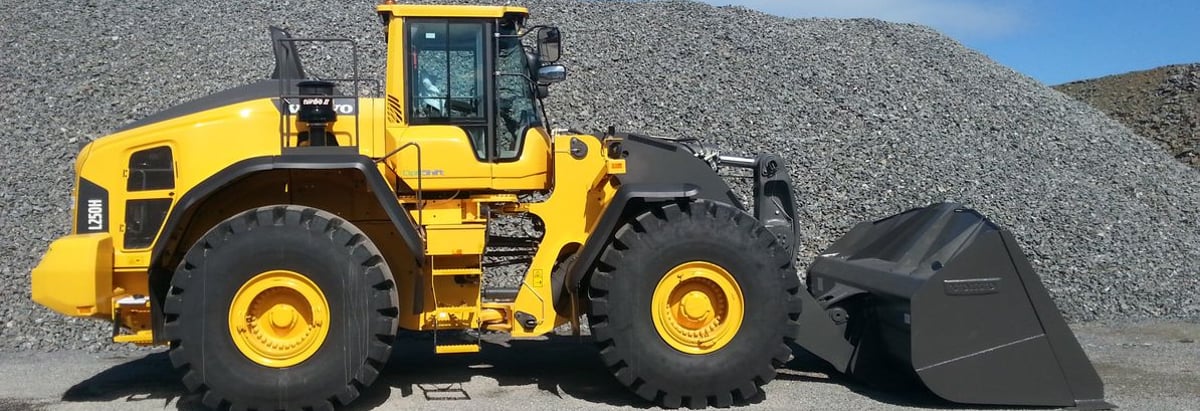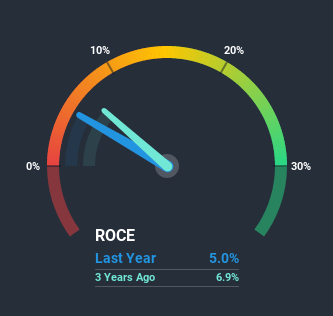
There are a few key trends to look for if we want to identify the next multi-bagger. One common approach is to try and find a company with returns on capital employed (ROCE) that are increasing, in conjunction with a growing amount of capital employed. This shows us that it's a compounding machine, able to continually reinvest its earnings back into the business and generate higher returns. However, after investigating Haldex (STO:HLDX), we don't think it's current trends fit the mold of a multi-bagger.
Return On Capital Employed (ROCE): What is it?
For those that aren't sure what ROCE is, it measures the amount of pre-tax profits a company can generate from the capital employed in its business. To calculate this metric for Haldex, this is the formula:
Return on Capital Employed = Earnings Before Interest and Tax (EBIT) ÷ (Total Assets - Current Liabilities)
0.05 = kr159m ÷ (kr4.3b - kr1.1b) (Based on the trailing twelve months to September 2020).
So, Haldex has an ROCE of 5.0%. Ultimately, that's a low return and it under-performs the Machinery industry average of 14%.
View our latest analysis for Haldex

In the above chart we have measured Haldex's prior ROCE against its prior performance, but the future is arguably more important. If you're interested, you can view the analysts predictions in our free report on analyst forecasts for the company.
How Are Returns Trending?
The trend of ROCE doesn't look fantastic because it's fallen from 22% five years ago, while the business's capital employed increased by 54%. However, some of the increase in capital employed could be attributed to the recent capital raising that's been completed prior to their latest reporting period, so keep that in mind when looking at the ROCE decrease. Haldex probably hasn't received a full year of earnings yet from the new funds it raised, so these figures should be taken with a grain of salt.
In Conclusion...
In summary, we're somewhat concerned by Haldex's diminishing returns on increasing amounts of capital. And, the stock has remained flat over the last five years, so investors don't seem too impressed either. With underlying trends that aren't great in these areas, we'd consider looking elsewhere.
If you'd like to know more about Haldex, we've spotted 3 warning signs, and 1 of them is a bit unpleasant.
While Haldex isn't earning the highest return, check out this free list of companies that are earning high returns on equity with solid balance sheets.
When trading Haldex or any other investment, use the platform considered by many to be the Professional's Gateway to the Worlds Market, Interactive Brokers. You get the lowest-cost* trading on stocks, options, futures, forex, bonds and funds worldwide from a single integrated account. Promoted
Valuation is complex, but we're here to simplify it.
Discover if Haldex might be undervalued or overvalued with our detailed analysis, featuring fair value estimates, potential risks, dividends, insider trades, and its financial condition.
Access Free AnalysisThis article by Simply Wall St is general in nature. It does not constitute a recommendation to buy or sell any stock, and does not take account of your objectives, or your financial situation. We aim to bring you long-term focused analysis driven by fundamental data. Note that our analysis may not factor in the latest price-sensitive company announcements or qualitative material. Simply Wall St has no position in any stocks mentioned.
*Interactive Brokers Rated Lowest Cost Broker by StockBrokers.com Annual Online Review 2020
Have feedback on this article? Concerned about the content? Get in touch with us directly. Alternatively, email editorial-team (at) simplywallst.com.
About OM:HLDX
Haldex
Haldex AB (publ), together with its subsidiaries, develops, produces, and sells brake and air suspension products.
Adequate balance sheet and slightly overvalued.
Similar Companies
Market Insights
Community Narratives




